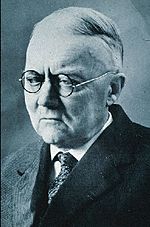Ernst Öpik facts for kids
Quick facts for kids
Ernst Öpik
|
|
|---|---|

Ernst Öpik
|
|
| Born | 22 October 1893 Kunda, Lääne-Viru, Russian Empire (current Estonia)
|
| Died | 10 September 1985 (aged 91) |
| Nationality | Estonian |
| Alma mater | |
| Awards |
|
| Scientific career | |
| Fields | Astronomy |
| Institutions | Armagh Observatory |
Ernst Julius Öpik (born October 22, 1893 – died September 10, 1985) was an Estonian astronomer and astrophysicist. He spent a big part of his working life, from 1948 to 1981, at the Armagh Observatory in Northern Ireland. He made many important discoveries about space, from how far away galaxies are to where comets come from.
Contents
Early Life and Education
Ernst Öpik was born in Kunda, a town in Estonia, which was then part of the Russian Empire. From a young age, he was very interested in space. He went to the University of Moscow to study small space objects. These included asteroids, comets, and meteors. Later, he finished his advanced studies at the University of Tartu in Estonia.
Amazing Discoveries in Space
Ernst Öpik was a very clever scientist who made many important discoveries. He helped us understand more about stars, galaxies, and even the Moon.
Understanding Stars and Galaxies
In 1916, Öpik wrote an article about how dense some stars are. He looked at a type of star called a white dwarf. He found that one of these stars, called ο2 Eridani B, was incredibly dense. It was 25,000 times denser than our Sun!
In 1922, Öpik figured out how far away the Andromeda Galaxy is. He used a new way to measure its distance. He looked at how fast the galaxy was spinning. His measurement was 450 kiloparsecs (kpc), which is about 1.5 million light-years. This was very close to what scientists believe today (about 2.5 million light-years). His method is still used by astronomers.
Predicting Craters and Comets
In 1922, Öpik also correctly guessed how many craters would be on Mars. He made this prediction long before space probes could actually see them.
In 1932, he came up with a theory about where comets in our Solar System come from. He thought they came from a huge cloud of icy objects. This cloud would be very far away, even beyond the orbit of Pluto. This idea was so important that the cloud is now called the Oort cloud. Sometimes, it's even called the Öpik-Oort Cloud in his honor.
Studying Meteors
From 1931 to 1933, Öpik led a special trip to Arizona to study meteors. During this trip, his team found about 22,000 meteors! He also invented a special camera, called a rocking camera, to help study them better.
How Stars Make Energy
In 1951, Öpik wrote about something called the triple-alpha process. This is how helium-4 turns into carbon-12 inside very old, big stars called red giants. This process is how stars create heavier elements.
The Moon's Origin
In 1972, Öpik wrote about how the Moon might have formed. He suggested that the Moon was captured by Earth's gravity. He also thought it might have broken apart and then come back together.
The Yarkovsky Effect
Ernst Öpik also helped make sure an important idea called the Yarkovsky effect was not forgotten. This effect was discovered by a Russian engineer named Ivan Yarkovsky around 1900. He realized that small objects in space, like asteroids and meteoroids, can be pushed around by sunlight. Even though the push is tiny, it can change their paths over a long time. Öpik read about this effect in 1909 and later showed how important it was for understanding how meteoroids move around the solar system.
Life as a Refugee
In 1944, Öpik had to leave his home country, Estonia. This was because the Red Army was approaching, and many Estonians were afraid. He became a refugee in Germany. While there, he helped lead the Baltic University in Exile, which was for students who were also refugees.
Even though he was offered good jobs in America, Öpik chose to stay at the Armagh Observatory in Northern Ireland from 1948. For some years, he also worked at the University of Maryland in the U.S. He would visit there once a year. But as air travel became more common, he stopped flying. This made it too hard for him to travel to the U.S. every year.
Awards and Recognition
Ernst Öpik received many important awards for his work:
- The J. Lawrence Smith Medal in 1960.
- The Frederick C. Leonard Memorial Medal in 1968.
- The Kepler Gold Medal in 1972.
- The Gold Medal of the Royal Astronomical Society in 1975.
- The Bruce Medal in 1976.
His Legacy in Space
Ernst Öpik's work left a lasting mark on astronomy.
- The Oort cloud, where comets are thought to come from, is sometimes called the "Öpik-Oort cloud."
- A special camera on the Comet Interceptor mission, called OPIC (Optical Periscopic Imager for Comets), is named after him. This celebrates Estonia's first contribution to a European Space Agency mission.
- An asteroid is named after him: 2099 Öpik.
- A crater on Phobos, one of Mars's moons, is also named Öpik.
His grandson, Lembit Öpik, is also known for his interest in space. He was a member of the British Parliament and has spoken about finding asteroids that might hit Earth.
See also
 In Spanish: Ernst Öpik para niños
In Spanish: Ernst Öpik para niños

